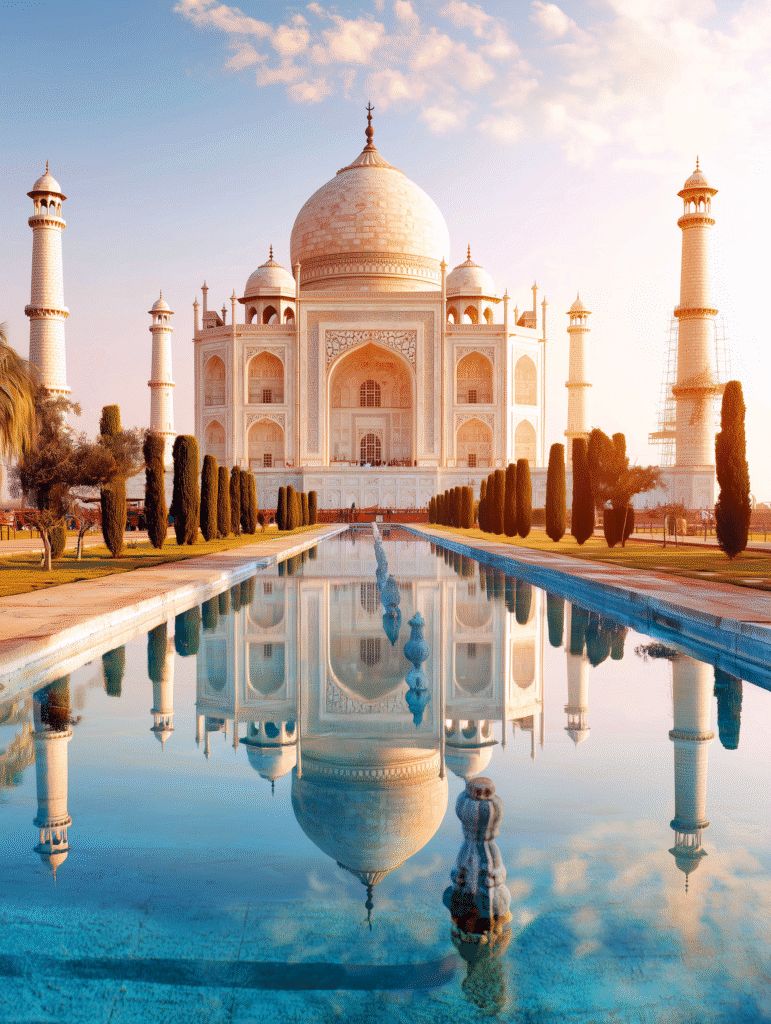Your basket is currently empty!
STONE THROUGH HISTORY – TAJ MAHAL
When Stone Becomes Poetry: The Taj Mahal’s Eternal Marble Symphony

Love transformed into eternal stone
In the heart of Agra, where the Yamuna River whispers ancient secrets to the wind, stands humanity’s most sublime love letter carved in stone. The Taj Mahal rises like a dream materialized, its pristine white marble facade breathing with an otherworldly luminescence that has captivated souls for nearly four centuries. This is not merely architecture—this is love transformed into eternal stone, where every grain of marble pulses with the heartbeat of a grief-stricken emperor’s devotion.
The story begins in the sun-scorched quarries of Makrana, nestled in Rajasthan’s Aravalli Hills, where nature spent millions of years crafting the perfect canvas for love’s greatest masterpiece. Here, beneath layers of earth and time, lay dormant the metamorphic miracle that would become the Taj Mahal’s soul. This isn’t ordinary marble—it’s a geological poetry written in calcium carbonate, born from ancient seas and refined by immense pressure into something approaching divine perfection.
Makrana marble, the celestial stone
The Makrana marble possesses an almost mystical quality that sets it apart from its earthly cousins. Its crystalline structure creates a translucent depth that seems to glow from within, as if capturing and holding fragments of starlight. When Emperor Shah Jahan’s architects first beheld these pristine blocks emerging from the quarries, they knew they had found the only material worthy of housing his eternal love for Mumtaz Mahal, his beloved queen whose death had torn his world asunder.
Each slab of this celestial stone underwent a transformation that bordered on the alchemical. Master craftsmen, their hands guided by generations of inherited wisdom, coaxed the marble into submission with tools that sang against its surface. The polishing process alone was an art form—countless hours of patient grinding with progressively finer abrasives until the stone achieved a mirror-like finish that could reflect not just light, but the very essence of human emotion.
The marble’s surface tells a story of technical mastery that still astounds modern engineers. Its silky texture, smooth as morning mist and cool as moonlight, invites touch while simultaneously commanding reverence. This tactile poetry emerges from the stone’s unique composition—pure white calcite crystals interlocked so perfectly that they create a surface of unparalleled uniformity and softness.
But the true magic reveals itself in the marble’s relationship with light. From the rose-gold blush of dawn, when the monument appears to awaken from slumber, to the silver-blue embrace of moonlight that transforms it into an ethereal specter, the Taj Mahal’s marble performs a daily dance with the cosmos. This chameleon-like quality stems from the stone’s semi-translucent nature—light doesn’t merely bounce off its surface but penetrates slightly, creating an inner glow that seems to emanate from the very heart of the structure.
The finest marriage of marble and artistr
The intricate inlay work, known as pietra dura, represents perhaps the finest marriage of marble and artistry ever achieved. Precious and semi-precious stones—cornelian, jasper, turquoise, and lapis lazuli—were carved into delicate floral patterns and set into the marble with such precision that the joints remain invisible to this day. These inlays don’t merely decorate the marble; they become part of its very essence, creating a symphony of color and texture that shifts and shimmers as viewers move around the monument.
The emotional resonance of this marble transcends its physical properties. When millions of pilgrims place their hands upon its cool surface, they’re not just touching stone—they’re connecting with Shah Jahan’s grief, his love, his desperate desire to create something beautiful enough to house his memories of Mumtaz. The marble becomes a conduit for human emotion, absorbing and reflecting the hopes, dreams, and sorrows of countless visitors across the centuries.
From an engineering perspective, the marble’s durability has proven remarkable. Despite centuries of weathering, pollution, and the gentle erosion of millions of touches, the Taj Mahal’s surface retains much of its original luminosity. This longevity speaks to both the quality of the Makrana stone and the skill of the Mughal craftsmen who understood how to work with its natural properties rather than against them.
Today, as conservation efforts work to preserve this marble masterpiece for future generations, we’re reminded that the Taj Mahal represents more than architectural achievement—it’s a testament to the transformative power of love and loss, expressed through the most eloquent medium nature provides. In its white marble walls, we see reflected not just light, but the eternal human capacity to create beauty from sorrow, to build monuments that outlast empires, and to touch the infinite through the simple act of shaping stone with devoted hands.
The Taj Mahal’s marble will continue to glow, continue to inspire, continue to remind us that true love, like the finest stone, only grows more beautiful with time.
